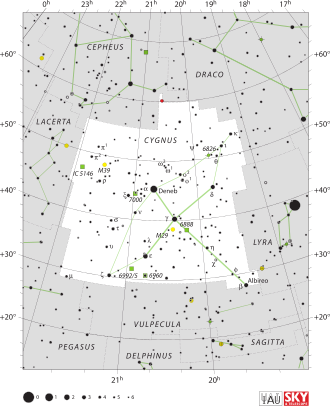astro.wikisort.org - Stern
Kepler-1625 ist ein Stern im Sternbild Schwan, der rund 8000 Lichtjahre von der Sonne entfernt ist. Er wird von mindestens einem Exoplaneten umkreist, der seinerseits möglicherweise von einem Exomond begleitet wird. Kepler-1625 hat eine scheinbare Helligkeit von nur rund 14 mag (K-Band) und kann somit nicht mit dem bloßen Auge beobachtet werden.
| Stern Kepler-1625 | |||||
|---|---|---|---|---|---|
 | |||||
| AladinLite | |||||
| Beobachtungsdaten Äquinoktium: J2000.0, Epoche: J2000.0 | |||||
| Sternbild | Schwan | ||||
| Rektaszension | 19h 41m 43,04s [1] | ||||
| Deklination | +39° 53′ 11,5″ [1] | ||||
| Bekannte Exoplaneten | 1 [2] | ||||
| Helligkeiten | |||||
| Spektrum und Indices | |||||
| Astrometrie | |||||
| Parallaxe | 0,41 ± 0,04 mas [1] | ||||
| Entfernung | (8000) Lj (2400) pc | ||||
| Eigenbewegung [1] | |||||
| Rek.-Anteil: | (−2,14 ± 0,06) mas/a | ||||
| Dekl.-Anteil: | (−4,80 ± 0,07) mas/a | ||||
| Physikalische Eigenschaften | |||||
| Masse | 0,96 M☉ [3] | ||||
| Radius | 0,94 R☉ [3] | ||||
| Effektive Temperatur | 5700 K [3] | ||||
| Metallizität [Fe/H] | 0,0 [3] | ||||
| Alter | 4 Mrd. a [4] | ||||
| Andere Bezeichnungen und Katalogeinträge | |||||
| |||||
Planetensystem
Basierend auf Beobachtungen des Sterns durch das Weltraumteleskop Kepler mittels der Transitmethode wurde 2016 die Entdeckung eines Planeten um Kepler-1625 bekanntgegeben, der die Bezeichnung Kepler-1625b trägt.[2] Nach 2017 veröffentlichten Untersuchungen wird der etwa jupitergroße Planet möglicherweise von einem neptungroßen Mond umkreist.[5]
Einzelnachweise
- SIMBAD: Kepler-1625. Abgerufen am 8. Oktober 2018.
- T. Morton u. a.: False positive probabilties for all Kepler Objects of Interest: 1284 newly validated planets and 428 likely false positives. arxiv:1605.02825.
- Kepler-1625b. In: NASA Exoplanet Archive. Abgerufen am 8. Oktober 2018.
- S. Mathur u. a.: Revised Stellar Properties of Kepler Targets for the Q1-17 (DR25) Transit Detection Run. arxiv:1609.04128.
- A. Teachey u. a.: HEK VI: On the Dearth of Galilean Analogs in Kepler and the Exomoon Candidate Kepler-1625b I. arxiv:1707.08563.
На других языках
- [de] Kepler-1625
[en] Kepler-1625
Kepler-1625 is a 14th-magnitude solar-mass star located in the constellation of Cygnus approximately 8,000 light years away. Its mass is within 5% of that of the Sun, but its radius is approximately 70% larger reflecting its more evolved state. A candidate gas giant exoplanet was detected by the Kepler Mission around the star in 2015,[7] which was later validated as a likely real planet to >99% confidence in 2016.[8] In 2018, the Hunt for Exomoons with Kepler project reported that this exoplanet has evidence for a Neptune-sized exomoon around it, based on observations from NASA’s Kepler Mission.[9] Subsequent observations by the larger Hubble Space Telescope provided compounding evidence for a Neptune-sized satellite, with an on-going debate about the reality of this exomoon candidate.[10][11][12][ru] Kepler-1625
Kepler-1625 — звезда 14-й звёздной величины в созвездии Лебедя. Находится на расстоянии около 4000 световых лет от Солнца.Текст в блоке "Читать" взят с сайта "Википедия" и доступен по лицензии Creative Commons Attribution-ShareAlike; в отдельных случаях могут действовать дополнительные условия.
Другой контент может иметь иную лицензию. Перед использованием материалов сайта WikiSort.org внимательно изучите правила лицензирования конкретных элементов наполнения сайта.
Другой контент может иметь иную лицензию. Перед использованием материалов сайта WikiSort.org внимательно изучите правила лицензирования конкретных элементов наполнения сайта.
2019-2025
WikiSort.org - проект по пересортировке и дополнению контента Википедии
WikiSort.org - проект по пересортировке и дополнению контента Википедии